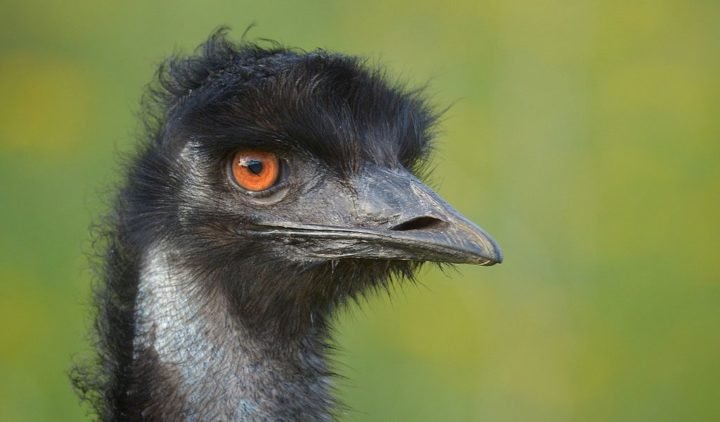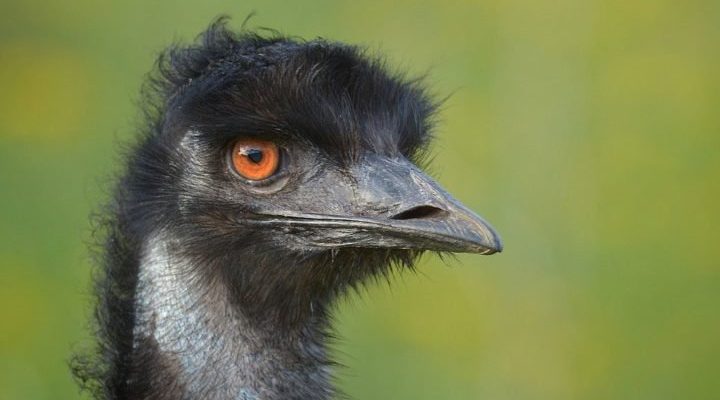
The emu is part of a group called ratites, which includes a few other interesting birds. If you’re curious about the avian family tree, you might be surprised to learn how many species are related and what sets them apart. So, whether you’re a birdwatching enthusiast or just someone who loves learning about unique wildlife, let’s get to know these fascinating creatures that, like the emu, strut their stuff without flying.
1. Ostrich
If there’s one bird that often gets compared to the emu, it’s the ostrich. These birds are the largest living species of bird, and they’re native to Africa. Imagine an emu but on steroids! An adult ostrich can stand up to 9 feet tall, making them nearly twice the height of an emu. Both birds have long necks and legs, but the ostrich has a more robust build.
One key difference is their coloring. While emus usually sport a grayish-brown hue with soft feathers, ostriches have distinct black and white plumage. Male ostriches flaunt black feathers, while the females are more muted in color. If you’re observing these birds, remember that emus have a more shaggy appearance, giving them a fluffier look compared to the sleek ostrich.
Quick Comparison:
- Height: Ostrich (up to 9 feet) vs. Emu (up to 6 feet)
- Color: Ostrich (black and white) vs. Emu (grayish-brown)
- Location: Ostrich (Africa) vs. Emu (Australia)
2. Kiwi
Kiwis are small, flightless birds from New Zealand that are incredibly cute but also quite different from emus. While emus are large and gangly, kiwis are about the size of a domestic chicken. Their round bodies, long beaks, and brown, fuzzy feathers make them adorable.
The biggest difference lies in their size and habitat. Kiwis have a more compact build, with a short neck and sturdy legs. They spend most of their time foraging on the ground, using their long beaks to probe the soil for insects and worms. If you see a bird scuttling around in the underbrush, it’s likely a kiwi rather than an emu, which would be strutting around more confidently in the open.
Quick Comparison:
- Size: Kiwi (the size of a chicken) vs. Emu (larger)
- Habitat: Kiwi (New Zealand forests) vs. Emu (Australian grasslands)
- Appearance: Kiwi (fuzzy, round) vs. Emu (tall, lanky)
3. Cassowary
Now, let’s move on to another striking member of the ratite family: the cassowary. Found in the tropical forests of New Guinea, nearby islands, and northern Australia, they’re even more striking than emus thanks to their bright blue and black coloration. Cassowaries can weigh up to 130 pounds and stand 5 to 6 feet tall, making them quite imposing.
What sets cassowaries apart is their casque—a helmet-like structure on their heads. While emus have a more uniform appearance, cassowaries are known for the vibrant colors of their skin and their impressive size. Despite looking intimidating, cassowaries are generally shy and elusive, preferring to roam their dense forest habitats rather than open plains.
Quick Comparison:
- Color: Cassowary (blue and black) vs. Emu (grayish-brown)
- Habitat: Cassowary (tropical forests) vs. Emu (grasslands)
- Distinctive Feature: Cassowary (casque) vs. Emu (no casque)
4. Rhea
Rheas are large, flightless birds from South America that share a few similarities with emus. They stand around 5 to 6 feet tall and have long necks and legs. While they may not be as well-known as their emu cousins, they have their own unique charm with a slightly more slender body shape.
One way to tell rheas apart from emus is their plumage. Emus have soft, fluffy feathers, while rheas have longer, more elegant feathers that give them a more streamlined appearance. Rheas tend to live in open grasslands and enjoy running in groups, which is a sight to behold. Just remember, if you’re in South America and see a bird that looks like an emu, it might just be a rhea!
Quick Comparison:
- Location: Rhea (South America) vs. Emu (Australia)
- Body Shape: Rhea (slender) vs. Emu (bulkier)
- Plumage: Rhea (long feathers) vs. Emu (fluffy)
5. Kākāpō
This one might surprise you. The kākāpō, a rare parrot species from New Zealand, is another flightless bird but differs significantly from the emu. While emus are large and mostly herbivorous, kākāpōs are smaller, about the size of a cat, and are nocturnal and more colorful, sporting bright green and yellow feathers.
Unlike emus, kākāpōs are also notable for their unique breeding behaviors. Male kākāpōs engage in a booming call to attract females during breeding season, while emus don’t have such elaborate courtship rituals. If you see a round, green bird waddling in the underbrush, chances are you’re looking at a kākāpō instead of an emu.
Quick Comparison:
- Size: Kākāpō (the size of a cat) vs. Emu (much larger)
- Color: Kākāpō (bright green/yellow) vs. Emu (grayish-brown)
- Behavior: Kākāpō (nocturnal, vocal) vs. Emu (diurnal, less vocal)
6. Flightless Cormorant
Next up is the flightless cormorant, which can be found only on the Galápagos Islands. These birds are often mistaken for ducks due to their size and shape, but they hold a distinctive place in the bird family. While they aren’t as big as emus, their unique adaptations to island life make them equally fascinating.
What makes flightless cormorants special is their webbed feet and strong legs, which help them swim rather than fly. Unlike emus, which prefer to wander on land, flightless cormorants spend a lot of their time in the water. If you observe a bird standing by the shore with a wet body and wings held high, it’s probably a cormorant drying off after a swim, not an emu.
Quick Comparison:
- Habitat: Flightless Cormorant (Galápagos Islands) vs. Emu (Australia)
- Behavior: Cormorant (swimming) vs. Emu (walking/running)
- Body Shape: Cormorant (more aquatic) vs. Emu (land bird)
7. Aepyornis (Moa)
While they’re extinct, let’s not forget about the *Aepyornis*, also known as the elephant bird or moa. Native to Madagascar, these gigantic birds are believed to have stood over 10 feet tall, dwarfing the emu. They were primarily herbivores and had a similar body shape to the emu, but their massive size sets them apart.
The intriguing fact about *Aepyornis* is that they laid some of the largest eggs in the bird kingdom—about the size of a basketball! If you were to see one side by side with an emu, the emu would look quite petite. Even though they no longer roam the earth, their fascinating history offers a glimpse into the diversity of avian life.
Quick Comparison:
- Size: Aepyornis (over 10 feet) vs. Emu (up to 6 feet)
- Location: Aepyornis (Madagascar) vs. Emu (Australia)
- Extinction: Aepyornis (extinct) vs. Emu (still alive)
8. Dodo
Similar to the *Aepyornis*, the dodo is another famous extinct bird that once lived on the island of Mauritius. Dodos were about the same height as emus, but they had a stout, round body and a distinct beak that made them look quite unique. Unlike the elegant legs of an emu, dodos had short, sturdy legs suitable for their forest habitat.
Dodos were flightless and spent much of their time foraging for fruits and seeds on the ground. While they were not closely related to emus, their flightless status and interesting anatomy make them a fun comparison. Today, they serve as a reminder of the importance of conservation and protecting wildlife habitats.
Quick Comparison:
- Size: Dodo (similar to emu) vs. Aepyornis (much larger)
- Habitat: Dodo (island forests) vs. Emu (grasslands)
- Extinction: Dodo (extinct) vs. Emu (still alive)
9. Kākā
Let’s circle back to New Zealand for another unique bird: the kākā. While they have a similar ecological niche to the emu, kākās are smaller and possess beautiful, colorful feathers. You can identify them by their bright green wings and striking red-orange undersides.
Kākās are social creatures that thrive in forest environments, unlike the more solitary emus. They are also known for their playful behaviors and affectionate demeanor. If you spot a lively parrot-like bird in the trees of New Zealand, it’s a good bet you’re looking at a kākā rather than an emu.
Quick Comparison:
- Size: Kākā (smaller) vs. Emu (larger)
- Color: Kākā (vibrant colors) vs. Emu (grayish-brown)
- Behavior: Kākā (social) vs. Emu (more solitary)
10. Greater Rhea
Finally, we have the greater rhea, a close relative of the rhea we talked about earlier. Found in Argentina, Brazil, and Uruguay, these birds are quite similar in appearance to emus—long legs, long necks, and flightlessness. They can grow over 5 feet tall and are a sight to see when they run in groups.
Unlike the emu, which has a more solid body, greater rheas have a leaner profile. They also have a beautiful mix of brown and gray feathers that help them blend in with their surroundings. If you encounter a flock of these birds running around, you’ll notice they possess a certain grace that might remind you of emus, but they carry a unique charm of their own.
Quick Comparison:
- Location: Greater Rhea (South America) vs. Emu (Australia)
- Height: Greater Rhea (up to 5 feet) vs. Emu (up to 6 feet)
- Body Type: Greater Rhea (leaner) vs. Emu (bulkier)
There you have it! Ten fascinating animals that are similar to the emu, each with their own special characteristics. From the towering ostrich to the adorable kiwi, these birds remind us of the incredible diversity found in the avian world. Next time you think of the emu, remember these relatives and how they contribute to the wonderful tapestry of wildlife. Whether in your backyard or halfway across the world, the wonders of nature are always waiting to be explored!

